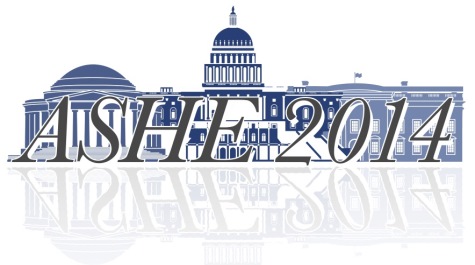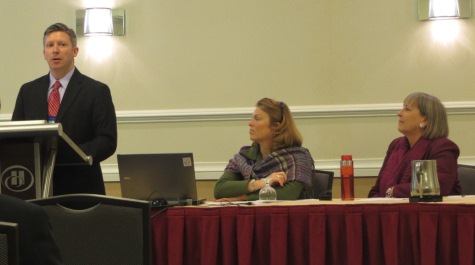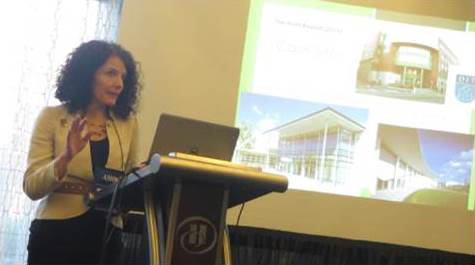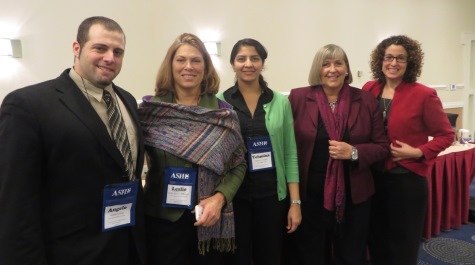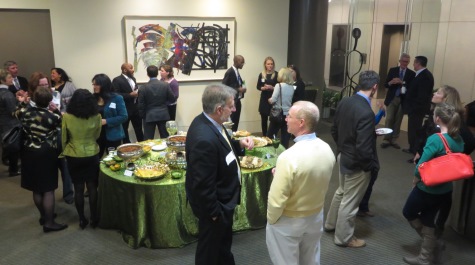Association for the Study of Higher Education (ASHE) Conference
William and Mary’s School of Education was well-represented at the 2014 ASHE annual conference held in Washington, D.C. The William & Mary representatives including faculty, students, and alumni presented 16 papers at the conference. A list of all William & Mary presentations follows:
The 3 A’s of Community Colleges: Affordability, Access, and Accountability (Presidential Session) by Professor Pamela L. Eddy
Forging Scholars: An Autoethnographic Reflection on First-Year Faculty Experiences by Assistant Professor Eddie Cole
Moving Up? Upward Mobility (or the Lack Thereof) in the USNWR Rankings by Jeremy P. Martin, PhD ’12
Preparing the Next Generation of College Educators and Scholars: Countering Chain Migration and Familismo for Latinas in Higher Education by Carla Costello, PhD '14 and Diana Hernández, PhD Student Higher Education
College Presidents’ Historical Approaches to Managing Student Unrest: An Exploration of North Carolina in the 1960s by Assistant Professor Eddie Cole
Articulate Leadership: A Discourse Analysis of Inaugural Addresses by Female and Male Presidents of Research Universities by Tehmina Khwaja, PhD Student Higher Education
Toward a Substantive Theory of Self-Authorship Development among Student Veterans in Community College by Sharon Stone, PhD ’14
Toward the Global Public Good by Angelo Letizia, PhD ’14
Women in the Trenches: Barriers to Female Staff’s Advancement in Higher Education by Carla Costello, PhD '14
Distant Memories, Current Implications: Experiencing the 1960s Impact on Teaching andScholarship in Higher Education (Symposium) by Professor Emerita Dorothy E. Finnegan
Developmental Pathways of African-American Students: A Longitudinal Study of Development in Context by Assistant Professor James Barber
Educators’ Voices: Examining the Characteristics of Integrative Learning Experiences by Assistant Professor James Barber and PhD higher education students Leslie Bohon and Nancy Everson
Students Higher Education Policy Processes Involved in International Higher Education by Professor Pamela Eddy and Sean Kelleher, master’s student in Public Policy
Using Propensity Score Weighted Frontier Fuzzy Regression Discontinuity Design to Estimate the Impact of Receiving the PROMISE Scholarship by Neal Holly, PhD ’12
Collegiality Experiences and Expectations of Full- Time, Non-Tenure-Track Faculty Members by Nathan Alleman, PhD ’08
In addition to representing William & Mary at the conference, the higher education program faculty and the dean of the School of Education, Spencer Niles, hosted a reception for current students, alumni, and faculty. Around 35 members of the William & Mary community gathered at the William & Mary Washington DC office.
Higher education doctoral student Diana Hernández reflected on her experience as an attendee two years in a row, and her first time as a presenter at ASHE:
“Attending year two of the 2014 Association for the Study of Higher Education (ASHE) was different than year one. For one, it was intentionally less strategic. Last year after consulting with Dr. Pam Eddy, I set out to meet my scholar stars. The workshops I attended were those where they would be speaking and could have the possibility of meeting them. If I did not have the opportunity to meet them in one session I had outlined the next workshop where I could do so. It was all very well prepared. Year two was much more about getting a feel for the conference, observing who spoke with whom, who gathered together, who attended whose session. It was interesting to see and study the people dynamic. I was also more keenly aware of the sessions I attended and asked myself why I wanted to attend these particular sessions. I was practicing the “so what” question that we, as emerging scholars need to ask ourselves about our scholarship. Why did a particular session matter to me? Why did it matter in and for the academy? I found this a very insightful approach to combine with observing the people in the room and the questions that were asked. I can say that in year two I felt more grounded in my own scholarship. I listened to the information being shared in sessions with one year “under my belt.” I was thinking differently. I was developing and shaping thoughts from a different lens. Yes, I said it! I now really knew what this meant. I asked myself how my area of interest had changed from year one. If I was to start writing my dissertation now, how would it be different from last year? Would my work be timely? In essence, would my work, as I was thinking about it today, matter, and if so, how? I had about three hours on my drive back to Williamsburg to think through these questions. I have had conversations with peers and colleagues about what education means to me and have asked what it means to them. How can we as William and Mary (W&M) colleagues take our training and positively impact education? We will have the privilege to touch lives, whether it is a K-12 or higher education setting. How well we train, what we teach, how we teach it, and especially, what our actions model will impact all of the lives we touch. These are special and unique years. The relationships we build at W&M, ASHE, and at the other conferences we attend make a difference in our scholarship and in our lives. I co-presented with Dr. Carla Costello at ASHE for the first time. A scholar I met the previous day at another session graciously attended our Roundtable. Here was the perfect example of relationship building. The support received from her, and our W&M colleagues who also graciously supported us, created a meeting of minds in a different environment. Once Carla and I began to speak, the nerves just went away. It was a conversation amongst peers. Ideas were shared, questions were asked; it just flowed. By the time Carla and I looked at each other, the time was over. That was it. Wow! My first presentation at ASHE, year two was done. We are often told that by the time we reach dissertation stage that we are the experts. This was extremely difficult to grasp year one. Year two, however, I am beginning to think that it might just be so. I had a taste of it at ASHE. While there is still much ground to cover, ASHE provided the platform the test the waters. Was our idea good enough? Had we thought about it soundly? The feedback we received was quite valuable and hopefully next year we will be able to go back to ASHE with a more developed piece of this initial idea. Thank you to those of you who have taught me so much in just a year!”